- Research Article
- Abstract
- Introduction
- Specific Objectives
- Hypotheses
- Methodology
- Results and Discussion
- Incomes from Key Livelihoods Activities
- Distance Between Residence and Water Body
- Occupational Health Hazards and Incomes Loss
- Manday Loss
- Test of Relationship Between Socio-Economic Characteristics and Income Loss
- Test of Relationship Between Socio-Economic Characteristics and Manday Loss
- Test of Relationship Between the Occupational Health Hazards and Income Loss
- Test of Relationship Between the Occupational Health Hazards and Manday Loss
- Conclusion
- Recommendations
- References
Effects of Occupational Health Hazards on Artisanal Fish Production in Ogun State, Nigeria
Oyediran WO1*, Sodiya CI1, Omoare AM2 and Ogbonna CC2
1Department of Agricultural Extension and Rural Development, Federal University of Agriculture, Nigeria
2Department of Agricultural Education, Federal College of Education, Nigeria
Submission: February 28, 2017; Published: June 09, 2017
*Corresponding author: Oyediran WO, Department of Agricultural Extension and Rural Development, Federal University of Agriculture, Nigeria, Email: oyediran_wasiu@yahoo.com
How to cite this article: Oyediran W, Sodiya C, Omoare A, Ogbonna C. Effects of Occupational Health Hazards on Artisanal Fish Production in Ogun State, Nigeria. Ocean & fish Open Access J. 2017; 3(2): 555606. DOI: 10.19080/OFOAJ.2017.03.555606
- Research Article
- Abstract
- Introduction
- Specific Objectives
- Hypotheses
- Methodology
- Results and Discussion
- Incomes from Key Livelihoods Activities
- Distance Between Residence and Water Body
- Occupational Health Hazards and Incomes Loss
- Manday Loss
- Test of Relationship Between Socio-Economic Characteristics and Income Loss
- Test of Relationship Between Socio-Economic Characteristics and Manday Loss
- Test of Relationship Between the Occupational Health Hazards and Income Loss
- Test of Relationship Between the Occupational Health Hazards and Manday Loss
- Conclusion
- Recommendations
- References
Abstract
The study was carried out to assess the effects of occupational health hazards on artisanal fish production in Ogun State, Nigeria. Simple random sampling technique was used in the selection of 240 fisher-folks as sample size for this study. Descriptive statistics were used for the objectives while Pearson Product Moment Correlation was used to test the hypotheses. Results of this study revealed that the mean age of the respondents was 41.58 years. Majority (71.67%) of the respondents were males, had secondary education (68.33%) and spent 6-10 years in artisanal fishing. The result also indicated that the estimated income loss was N23,705.40 per month. Results of correlation showed that positive and significant relationship existed between occupational health hazards and income loss (p>0.05). It can be concluded that the artisanal fisher-folks are affected by occupational health hazards. Consequently, considerable incomes and manday are loss on daily basis by the victims in the study area. It is hereby recommended that fisher-folks should be trained by the extension agents on preventive measures in order to minimize the occupational health hazards associated with fishing in the study area.
Keywords: Effects; Artisanal fishing; Fisher-folks; Occupation; Health hazards
- Research Article
- Abstract
- Introduction
- Specific Objectives
- Hypotheses
- Methodology
- Results and Discussion
- Incomes from Key Livelihoods Activities
- Distance Between Residence and Water Body
- Occupational Health Hazards and Incomes Loss
- Manday Loss
- Test of Relationship Between Socio-Economic Characteristics and Income Loss
- Test of Relationship Between Socio-Economic Characteristics and Manday Loss
- Test of Relationship Between the Occupational Health Hazards and Income Loss
- Test of Relationship Between the Occupational Health Hazards and Manday Loss
- Conclusion
- Recommendations
- References
Introduction
Fish makes vital contribution to the food and nutritional security of 200 million Africans and provides income for over 10 million people mostly small-scale fisher-folks and entrepreneurs engaged in fish production [1]. Currently, domestic fish production is put at 551,700 metric tonnes as against the present national demand of about 1.5 million metric tonnes [2]. The shortfall is said to be bridged by the importation of 680,000 metric tonnes annually consuming about N50billion in foreign exchange [3]. This no doubt represents a significant drain on the national foreign reserve. Artisanal fish production accounts for 91% of total domestic fish supply in Nigeria [1]. Artisanal fishery is the harvesting of fish from rivers, streams, lakes and ponds by small scale fishermen using both traditional and modern fishing gears. It is the most important of fishery production in Nigeria and accounts for over 90% of her fishery production [4] Artisanal fishers are at the mercy of fluctuating prices, weather and the hazards of the sea. Fishers are vulnerable due to depleting stock arising from over fishing and excessive pressures on available resources, environmental degradation due to flooding, deforestation and menace of water hyacinth. Industrial activities such as oil spillage, canalization, construction of hydroelectric dams are also destabilizing ecosystem and fishing activities. Adoption of obnoxious fishing methods like the use of chemicals and explosives is seriously affecting artisanal fishing because it pollutes the water and destroys water body. In addition, Artisanal fishers are experiencing high post harvest fish losses due to poor processing methods and lack of refrigeration facilities, poor rural infrastructure particularly, health water and sanitation facilities and communal conflict. All these constituted major occupational health hazards and they are detrimental to the growth and development of artisanal fish production in Nigeria. That is, occupational health hazards contribute to low level of artisanal fish production in Nigeria. Having identified occupational health hazards as economic threat and that they affect the fishing households at the various level of fishing activities, it is essential to estimate the extent of manday loss to fisher-folks because this determines their productivity, output and income accruing to the affected fishing households in the area, as this is necessary, not because income from fish production represent the major source of livelihood in the coastal areas but also that labour shortage is apparent. In view of this background, there is need therefore to economically appraise the effects of occupational health hazards on artisanal fish production in Ogun State, Nigeria.
- Research Article
- Abstract
- Introduction
- Specific Objectives
- Hypotheses
- Methodology
- Results and Discussion
- Incomes from Key Livelihoods Activities
- Distance Between Residence and Water Body
- Occupational Health Hazards and Incomes Loss
- Manday Loss
- Test of Relationship Between Socio-Economic Characteristics and Income Loss
- Test of Relationship Between Socio-Economic Characteristics and Manday Loss
- Test of Relationship Between the Occupational Health Hazards and Income Loss
- Test of Relationship Between the Occupational Health Hazards and Manday Loss
- Conclusion
- Recommendations
- References
Specific Objectives
- Describe the socio-economic characteristics of the fisher-folks in the study area
- Estimate the incomes generated from key livelihoods activities by the fisher-folks in the study area
- Assess the distance of respondents' residence to the water body in the study area
- Evaluate the income and manday losses due to the health hazards in the study area
- Research Article
- Abstract
- Introduction
- Specific Objectives
- Hypotheses
- Methodology
- Results and Discussion
- Incomes from Key Livelihoods Activities
- Distance Between Residence and Water Body
- Occupational Health Hazards and Incomes Loss
- Manday Loss
- Test of Relationship Between Socio-Economic Characteristics and Income Loss
- Test of Relationship Between Socio-Economic Characteristics and Manday Loss
- Test of Relationship Between the Occupational Health Hazards and Income Loss
- Test of Relationship Between the Occupational Health Hazards and Manday Loss
- Conclusion
- Recommendations
- References
Hypotheses
- H01a: There is no significant relationship between the socio-economic characteristics of the respondents and income loss.
- H01b: There is no significant relationship between the socio-economic characteristics of the respondents and manday loss.
- H02a: There is no significant relationship between the occupational health hazards and income loss.
- IV. H02b: There is no significant relationship between the occupational health hazards and manday loss.
- Research Article
- Abstract
- Introduction
- Specific Objectives
- Hypotheses
- Methodology
- Results and Discussion
- Incomes from Key Livelihoods Activities
- Distance Between Residence and Water Body
- Occupational Health Hazards and Incomes Loss
- Manday Loss
- Test of Relationship Between Socio-Economic Characteristics and Income Loss
- Test of Relationship Between Socio-Economic Characteristics and Manday Loss
- Test of Relationship Between the Occupational Health Hazards and Income Loss
- Test of Relationship Between the Occupational Health Hazards and Manday Loss
- Conclusion
- Recommendations
- References
Methodology
Description of the study area
Ogun State is one of the six States in the south west Nigeria. The state was created in February 3rd, 1976. It is bounded in the west by Republic of Benin, bounded in the south by Lagos State and Atlantic Ocean, in the North by both Oyo and Osun States and in the East by Ondo State. The State lies between the latitudes 7°18'N and longitude 5° 55'E. It is situated within the tropics covering 16,409.29km2 with a population of about 4,054,272. Ogun State is heterogeneous state, inhabited predominantly by the Egba, Yewa, Ijebu, Remo, Awori and Egun who belong to the Yoruba ethnic group on the Africa Continents. The population of males in Ogun State is 1,847,243 while the population of female is 1,880,855 according to Nigeria Population Census final population release. The state is approximately covering 1.9 percent (i.e. 16,762km2) of Nigeria 923,219km2 land areas. The State has bimodal rainfall pattern which reaches its peak in July and September and it comprises of mostly agrarian communities which engages the farming activities of both males and females, in cash crops and food crops in order to meet the livelihood needs of the farmer, in addition to their foreign exchange. Most of the crops grown in Ogun State include cassava, rice, maize, melon, cotton, cocoyam, cocoa, yam, cowpea etc. The emphasis of traditional Agriculture in Ogun State is more on crops, while the livestock raised is supplementary. Cultivation and processing of melon is popular in the farming system of rural farmers (especially women) in Ogun State.
Sampling technique and sample size
Ogun Water-Side Local Government Area was purposively selected based on its riverine nature. It is one of the twenty Local Government Areas (LGAs) of Ogun State, Nigeria. The Local Government Area is bounded in the West by Ijebu East Local Government Area in the North, East by Ondo State and in the South by Lagos-State and the Atlantic Ocean [5]. The LGA covers area of about 860.2 square kilometers. It is the only LGA that links Ogun State with the Atlantic Ocean. It has some towns and villages on the fringes of Lagoon and Atlantic Ocean fronts. Thus, it has an ecological condition conducive for riverine, lagoon and marine artisanal fisheries. The traditional occupation of the inhabitants of the riverine, lagoon, and coastal locations is fishing but in recent times, there have been some diversification into other occupations such as arable faming, lumbering, boat building and trading. The Local Government Area consists of five administrative districts namely; Iwopin/Oni, Ibiade/ Ilusin, Abigi/Efire, Ayede/Ayila and Ode-Omi/Makun-Omi. The natural endowment of Iwopin and Ode-Omi areas of Lagoon and Atlantic Ocean respectively favours artisanal fishing in the study area, so the two communities were purposively selected for this study. Simple random sampling technique was used to select 120 fisher-folks from each the community to make up 240 respondents as sample size for this study.
Data collection method
Data collection was through primary source using interview guide, observations and memory recall. The instrument used for the data collection was subjected to content validity by experts in the field of Agricultural Extension and Rural Development. Items found ambiguous were removed. Test re-test was carried out at interval of two weeks with twenty fisher-folks who were not part of this study to ascertain the reliability of the instrument [6].
Measurement of variables
Age and fishing experience were measured at ratio level while sex, educational level and marital status were measured at nominal level [7]. Also, the distance, income loss and manday loss were measured at interval level while prevalence of occupational health hazards was measured at nominal level.
Data analysis
Simple descriptive statistics such as percentage, mean and frequency were used to describe the objectives while Pearson Product Moment Correlation was used to analyze the hypotheses.
- Research Article
- Abstract
- Introduction
- Specific Objectives
- Hypotheses
- Methodology
- Results and Discussion
- Incomes from Key Livelihoods Activities
- Distance Between Residence and Water Body
- Occupational Health Hazards and Incomes Loss
- Manday Loss
- Test of Relationship Between Socio-Economic Characteristics and Income Loss
- Test of Relationship Between Socio-Economic Characteristics and Manday Loss
- Test of Relationship Between the Occupational Health Hazards and Income Loss
- Test of Relationship Between the Occupational Health Hazards and Manday Loss
- Conclusion
- Recommendations
- References
Results and Discussion
The results in Table 1 showed that the mean age of the respondents was 41.58 years. About sixty percent (59.17%) of the respondents were between 40-49 years old while 10.83% of the fisher-folks were above 50 years of age. This shows that majority of the fisher-folks are at their active age; therefore they go about their business without any problem that goes along with old age. This finding is in consonance with Oyediran et al. [5] that the fisher-folks in this category are within the economically active population and therefore constitute a good labour force for fishery enterprise with the expectation that they would be good managers of limited available resources and can withstand rigors associated with the fishing activities. Majority (71.67%) of the respondents were males while only 28.33% were females. This indicates dominance of male folk in artisanal fish production in the study area. The result is in line with Oyediran et al. [5] that the male folks dominate fish production while female engaged in fish processing and marketing. Most (68.33%) of the respondents had secondary school education while 6.67% had tertiary education. However, 6.0% of the respondents did not have any formal education. This indicates that the fisher-folks are literate which in turn may affect the rate adoption of innovations in the study area. This result is in agreement with Asiabaka (2002) that educational level is a very important determinant in adoption of innovation. The mean household size was 4 people. Majority (70.0%) of the respondents had 2-4 people while 4.17% had more than 8 people in their households. This means that the household size of respondents were relatively small. The implication is that few hands will be involved in artisanal fish production. This result contradicts with Agbamu (2000) who said that the large number of persons in a family pave way for use of family labour in fish processing and marketing. The result also revealed that 60.83% of the respondents had spent between 6 -10 years while 12.50% of the respondents had been in the artisanal fish production for 11-15 years. The mean year of fishing experience was 8.50 years. This implies that artisanal fishing is not a new means of livelihood to the people in the study area (Table 1).

- Research Article
- Abstract
- Introduction
- Specific Objectives
- Hypotheses
- Methodology
- Results and Discussion
- Incomes from Key Livelihoods Activities
- Distance Between Residence and Water Body
- Occupational Health Hazards and Incomes Loss
- Manday Loss
- Test of Relationship Between Socio-Economic Characteristics and Income Loss
- Test of Relationship Between Socio-Economic Characteristics and Manday Loss
- Test of Relationship Between the Occupational Health Hazards and Income Loss
- Test of Relationship Between the Occupational Health Hazards and Manday Loss
- Conclusion
- Recommendations
- References
Incomes from Key Livelihoods Activities
Artisanal fishing is a major source of livelihood for the fisher-folks in the coastal areas. The findings of this study revealed various key livelihoods undertaking by the fisher-folks in the study area. From the results in Table 2, it was shown that 4.20% of the respondents that engaged in small scale fishing/ processing/ marketing realized as much as M8,030.00/month while the boat builders/net fabricators got M, 650.00/month. Also, 30.0% of the respondents generated N32,000.00/month from fish processing/marketing [8,9].
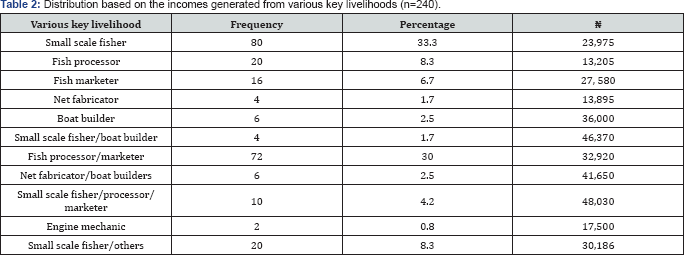
- Research Article
- Abstract
- Introduction
- Specific Objectives
- Hypotheses
- Methodology
- Results and Discussion
- Incomes from Key Livelihoods Activities
- Distance Between Residence and Water Body
- Occupational Health Hazards and Incomes Loss
- Manday Loss
- Test of Relationship Between Socio-Economic Characteristics and Income Loss
- Test of Relationship Between Socio-Economic Characteristics and Manday Loss
- Test of Relationship Between the Occupational Health Hazards and Income Loss
- Test of Relationship Between the Occupational Health Hazards and Manday Loss
- Conclusion
- Recommendations
- References
Distance Between Residence and Water Body
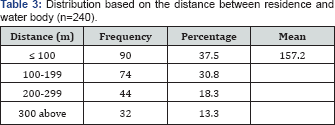
The close distance of the residence to the water body constitutes threats and potential hazards to the people in the coastal areas. The results in Table 3 showed that most (86.70%) of the respondents lived closer (less than 300m) to the water body while few (13.30%) resided farther away (more than 300m) from the water, streams and ponds [10]. The average distance was 157.20m. The finding reveals that the fisher-folks reside closer to the rivers and streams in the study area.
- Research Article
- Abstract
- Introduction
- Specific Objectives
- Hypotheses
- Methodology
- Results and Discussion
- Incomes from Key Livelihoods Activities
- Distance Between Residence and Water Body
- Occupational Health Hazards and Incomes Loss
- Manday Loss
- Test of Relationship Between Socio-Economic Characteristics and Income Loss
- Test of Relationship Between Socio-Economic Characteristics and Manday Loss
- Test of Relationship Between the Occupational Health Hazards and Income Loss
- Test of Relationship Between the Occupational Health Hazards and Manday Loss
- Conclusion
- Recommendations
- References
Occupational Health Hazards and Incomes Loss
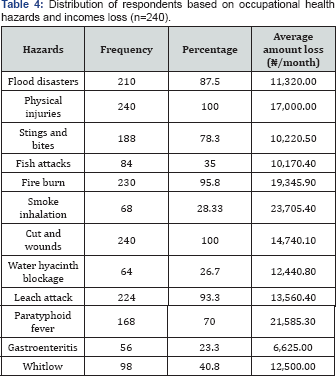
Good health contributes to the overall quality of life as well as to productivity. However, the occupational health hazards cause damages to the human health and his environment (Oxford Advanced Learner's Dictionary). The result in Table 4 showed that virtually all (100.0%) the respondents were affected by physical injuries, cuts and wounds. Also, most of the respondents experienced fire burns (95.80%), leech attack (93.30%), flood disaster (87.50%), stings and bites (78.30%) and paratyphoid fever (70.0%). The result also showed that 40.80% of the fisherfolks had experienced whitlow while 35.0% of the fisher-folks got fish attacks. However, all the fish processors (women) which are about 28.33% of the respondents were exposed to smoke inhalation during fish processing and smoking. Substantial amount of money were loss by the affected fisher-folks during the health breakdown. The amount of money loss as a result of the hazard was based on the subjective estimates given by the fishers during the peak season of their activities. The average amount of income loss to the occupational health hazards ranges from N6,625.00 to N23, 705.40 per month in the study area. These losses are excluding of cost incurred for the treatment of the health hazards (Table 4).
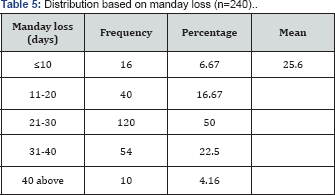
- Research Article
- Abstract
- Introduction
- Specific Objectives
- Hypotheses
- Methodology
- Results and Discussion
- Incomes from Key Livelihoods Activities
- Distance Between Residence and Water Body
- Occupational Health Hazards and Incomes Loss
- Manday Loss
- Test of Relationship Between Socio-Economic Characteristics and Income Loss
- Test of Relationship Between Socio-Economic Characteristics and Manday Loss
- Test of Relationship Between the Occupational Health Hazards and Income Loss
- Test of Relationship Between the Occupational Health Hazards and Manday Loss
- Conclusion
- Recommendations
- References
Manday Loss
A major challenge for the aquatic fish farmers is high occurrence of occupational health hazards. The findings in Table 3 showed that 50.0% of the fisher-folks loss 21-30 days to occupational health hazards while 4.16% of the fisher-folks loss more than 40 days to similar hazards. The mean manday loss was 25.60 days. The loss was as a result of absent from their works and incapacitation of the fisher-folks during the fishing activities. This implies that the fisher-folks losses considerable labour force to occupational health hazards in the coastal areas (Table 5).
- Research Article
- Abstract
- Introduction
- Specific Objectives
- Hypotheses
- Methodology
- Results and Discussion
- Incomes from Key Livelihoods Activities
- Distance Between Residence and Water Body
- Occupational Health Hazards and Incomes Loss
- Manday Loss
- Test of Relationship Between Socio-Economic Characteristics and Income Loss
- Test of Relationship Between Socio-Economic Characteristics and Manday Loss
- Test of Relationship Between the Occupational Health Hazards and Income Loss
- Test of Relationship Between the Occupational Health Hazards and Manday Loss
- Conclusion
- Recommendations
- References
Test of Relationship Between Socio-Economic Characteristics and Income Loss
Result of correlation showed significant but negative relationship between age (r = - 0.91), gender (r = - 0.32), household size (r =- 0.31) and income loss due to occupational health hazards at p>0.05 level of significance. It implies that the more the youths and middle aged individual with full of energy and fishing experience are involved in artisanal fish production the lesser the exposure to occupational health hazards and income loss. Similarly, women fisher-folks with fewer households are more prone to occupational health hazards than their counterpart men with larger household because more hands will be involved in the various fishing operations. However, fishing experience of the fisher-folks is negative but not significant to the income loss. Thus, there is an inverse relationship between socio-economic characteristics of the fisher-folks and income loss. Therefore, the null hypothesis is rejected while the alternate is accepted (Table 6).
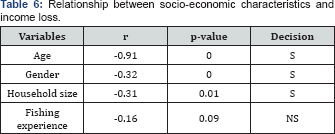
S= significant at p>0.05 level
NS= Not-Significant at p>0.05 level
- Research Article
- Abstract
- Introduction
- Specific Objectives
- Hypotheses
- Methodology
- Results and Discussion
- Incomes from Key Livelihoods Activities
- Distance Between Residence and Water Body
- Occupational Health Hazards and Incomes Loss
- Manday Loss
- Test of Relationship Between Socio-Economic Characteristics and Income Loss
- Test of Relationship Between Socio-Economic Characteristics and Manday Loss
- Test of Relationship Between the Occupational Health Hazards and Income Loss
- Test of Relationship Between the Occupational Health Hazards and Manday Loss
- Conclusion
- Recommendations
- References
Test of Relationship Between Socio-Economic Characteristics and Manday Loss
Result of correlation in Table 7 indicated that age (r =-0.89), gender (r =-0.25), were negatively significant to manday loss as a result of occupational health hazards at p>0.05 level of significance. This means that the more the younger fisher-folks especially males are involved in fishing activities the lesser the exposure to occupational health hazards and manday loss. On the other hand, if older fisher-folks are the dominants in the artisanal fishing operations, there is tendency for higher occupational hazards because of their old age and inactiveness. It is therefore means that there is an inverse but significant relationship between socio-economic characteristics of the respondents and manday loss. However, household size and fishing experience were negative but not significant to manday loss. Thus, the null hypothesis is rejected .

- Research Article
- Abstract
- Introduction
- Specific Objectives
- Hypotheses
- Methodology
- Results and Discussion
- Incomes from Key Livelihoods Activities
- Distance Between Residence and Water Body
- Occupational Health Hazards and Incomes Loss
- Manday Loss
- Test of Relationship Between Socio-Economic Characteristics and Income Loss
- Test of Relationship Between Socio-Economic Characteristics and Manday Loss
- Test of Relationship Between the Occupational Health Hazards and Income Loss
- Test of Relationship Between the Occupational Health Hazards and Manday Loss
- Conclusion
- Recommendations
- References
Test of Relationship Between the Occupational Health Hazards and Income Loss
The result of correlation showed a positive and significant relationship between occupational health hazards and income loss at p>0.05 level of significance. This implies that the more the fisher-folks are affected by the occupational health hazards the higher the income loss from their fishing production. For every 1% increase in the severance of occupational hazards, 91% of the income is lost. Thus, "there is no significant relationship between occupational health hazards and income loss" is rejected (Table 8).

S= significant at p>0.05 level
- Research Article
- Abstract
- Introduction
- Specific Objectives
- Hypotheses
- Methodology
- Results and Discussion
- Incomes from Key Livelihoods Activities
- Distance Between Residence and Water Body
- Occupational Health Hazards and Incomes Loss
- Manday Loss
- Test of Relationship Between Socio-Economic Characteristics and Income Loss
- Test of Relationship Between Socio-Economic Characteristics and Manday Loss
- Test of Relationship Between the Occupational Health Hazards and Income Loss
- Test of Relationship Between the Occupational Health Hazards and Manday Loss
- Conclusion
- Recommendations
- References
Test of Relationship Between the Occupational Health Hazards and Manday Loss

The result in Table 9 revealed a positive and significant relationship between occupational health hazards and manday loss at p>0.05 level of significance. The implication is that for every 1.0% of the occupational hazards 62.0% of manday is lost to the hazards. Thus, the null hypothesis that "there is no significant relationship between occupational health hazards and manday loss" is rejected.
- Research Article
- Abstract
- Introduction
- Specific Objectives
- Hypotheses
- Methodology
- Results and Discussion
- Incomes from Key Livelihoods Activities
- Distance Between Residence and Water Body
- Occupational Health Hazards and Incomes Loss
- Manday Loss
- Test of Relationship Between Socio-Economic Characteristics and Income Loss
- Test of Relationship Between Socio-Economic Characteristics and Manday Loss
- Test of Relationship Between the Occupational Health Hazards and Income Loss
- Test of Relationship Between the Occupational Health Hazards and Manday Loss
- Conclusion
- Recommendations
- References
Conclusion
It can be concluded that the artisanal fisher-folks are affected by occupational health hazards. Consequently, considerable incomes and manday are lost on daily basis by the victims of the occupational health hazards in the study area. These losses have serious implications in sustaining their fishing activities and meeting the basic household needs.
- Research Article
- Abstract
- Introduction
- Specific Objectives
- Hypotheses
- Methodology
- Results and Discussion
- Incomes from Key Livelihoods Activities
- Distance Between Residence and Water Body
- Occupational Health Hazards and Incomes Loss
- Manday Loss
- Test of Relationship Between Socio-Economic Characteristics and Income Loss
- Test of Relationship Between Socio-Economic Characteristics and Manday Loss
- Test of Relationship Between the Occupational Health Hazards and Income Loss
- Test of Relationship Between the Occupational Health Hazards and Manday Loss
- Conclusion
- Recommendations
- References
Recommendations
Based on the findings of this study it is hereby recommends that:
- Fisher-folks should be trained by the extension agents on preventive/safety measures in order to minimize the exposure to occupational health hazards in the study area
- Fisher-folks should also be encouraged to put safety tools into use in the study area
- Government should provide health care facilities to the coastal area
- Fire brigade service should be made closer to the grass root.
- Research Article
- Abstract
- Introduction
- Specific Objectives
- Hypotheses
- Methodology
- Results and Discussion
- Incomes from Key Livelihoods Activities
- Distance Between Residence and Water Body
- Occupational Health Hazards and Incomes Loss
- Manday Loss
- Test of Relationship Between Socio-Economic Characteristics and Income Loss
- Test of Relationship Between Socio-Economic Characteristics and Manday Loss
- Test of Relationship Between the Occupational Health Hazards and Income Loss
- Test of Relationship Between the Occupational Health Hazards and Manday Loss
- Conclusion
- Recommendations
- References
References
- World Fish Centre (2005) Fish and Food Security in Africa. Penang, Malaysia.
- Osawe M (2007) Technical know-how of Catfish Grow-out for Table size in 4-6 months. Proceeding Seminar on Modern Fish Farming by Dynamo Catfish Production, pp. 1-14.
- Odukwe A (2007) Fish Farming in the Tropics: A Functional Approach. Awka, Nigeria.
- Ogunbadejo HK, Alhaji T, Otubusin S (2007) Productivity of Labour in Artisanal fish farming in Nigeria. African Journal of Applied Zoology and Environmental Biology 9: 74-77.
- Oyediran WO, Omoare AM, Sodiya CI, Fakoya EO (2013) Capacity building for rural youths: Priorities for Sustainable Catfish Production in Ogun State, Nigeria. IOSR Journal of Agriculture and Veterinary Science (IOSR-JAVS) 4(2): 38-42.
- Agbamu JU (2000) Agricultural Extension Linkage System. An international perspective: Agricultural Research and Extension Network Development Institute, pp. 12-14.
- Akinwumi A (2012) Press briefing on Agricultural reform. In: Owuje Harry (Ed.), Tackling food insecurity. The Tide Newspaper.
- Asiabaka CC (2002) Determinants of Adoptive Behaviours of Rural Farmers in Nigeria. Proceedings of the 18th Annual Conference of Agricultural Economists, Durban, South Africa, pp. 13-20.
- Federal Department of Fisheries (2007) National Fish Frame and Catch Assessment Survey. Abuja, Nigeria.
- Oxford Advanced Learner's Dictionary of Current English. In: Hornby AS (Eds.), (8th edn), Oxford University Press, UK, p. 1732.






























